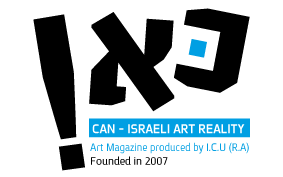
| Home Page | Editor Notices | Museums | Galleries | Publication | Donation | Contact Us |


 | |||||||||||||||
| |||||||||||||||


| |||||||||||||||
| Ruth Kadari |
Speaking of her current body of work, Ruth Kadari says: "Home is not only a structure, it's a safe haven, a place where you can be without masks." This personal insight is backed and filled with significance in her works; while she 'builds' and designs the painting, she plants various 'home' images. Sometimes, these images stand out clearly, in other works they are insinuated, reminding one of images of children's drawings, where the roof is sketched as a triangle. The presence of images of home in painting is a common motif in the history of art. The images symbolize stability, comfort and security, just as they can simultaneously symbolize social status or cultural identity. It seems that the symbolic home, appearing as a colorful, formal tempo in Kadari's works, is somewhere between personal expression and abstract or conceptual investigation processes, whether conscious or sub-conscious. Their presence is invoked to teach or express Kadari's personal and cultural identity, as well as her heart's desires. In this colorful fabric, Kadri creates structure, frames, sharp and precise color changes, and clear colors. These seem like complete, independent structures, each standing on its own, but simultaneously creating one complete synergetic structure, causing the whole to be more than the sum of its parts. The hand, carrying out the plans conceived by the mind, creates a fascinating combination of disciplined design, on the one hand, and liberty and imagination, on the other. And as the clear or implied image of home reminds one of children's drawings, so the work itself is on the border between meticulous design and a free, playful style, alluding to children's drawings. This style can imply a sense of naivet? or playfulness, as well as a sense of nostalgia or yearning for a simpler era, without worries. Kadri notes that she chooses a form of painting that describes and implies a deep awareness of the inner voice, allowing it room, while still being under control. This is an intriguing process between freedom and borders, with all the implications. And beyond the personal message and its universal importance, Kadari continues her exploration and study of the borders between 'high' and 'low' art. Kadari uses elements of children's style, such as strong colors, abstract or symbolic forms, powerful paintbrush strokes and clear borders, paintings that imply a collage. This style is often controversial, and is sometimes considered a cultural or trivial appropriation of concrete childhood experiences; still, when it is carried out respectfully, and with sincere intention, as in Kadari's case, the style can serve as a powerful tool in studying complex issues and emotions, and can create a sense of access and containment in art. Creating art is, for Kadari, a sense of home. The space where she places the physical materials – color, form, material, the chosen images, the spontaneous signs and forms – intended or by accident. All these are a place to be in, just as the canvas is a form of home and property. Kadari combines familiar images, such as home, and her personal point of view. As a painter she expresses herself in her home, and art is her home. Dr. Nurit Cederbaum Read more  |
| all rights reserved - CAN ISRAELI ART REALITY |
| סייבורג מחשבים - בניית אתרים |